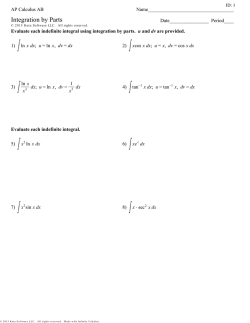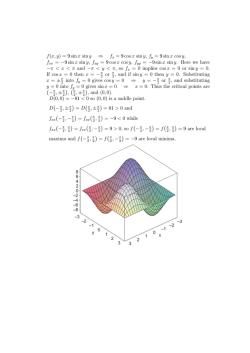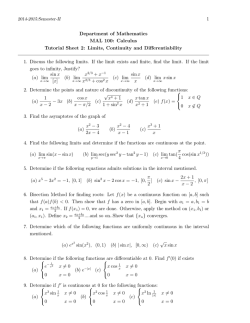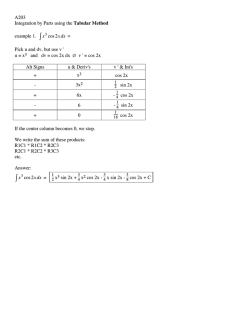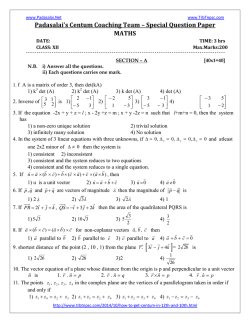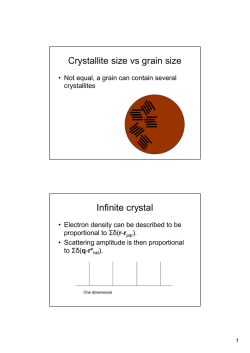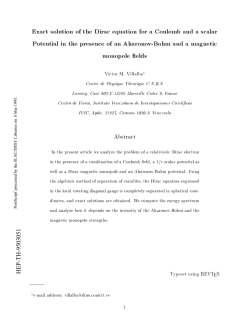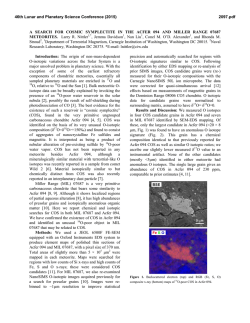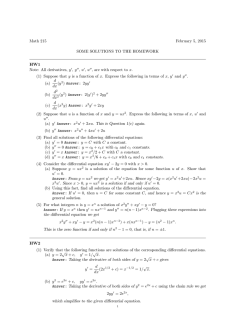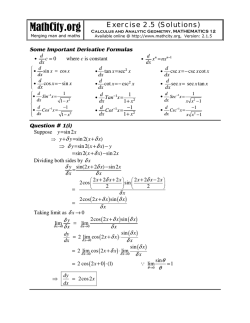
version of February 14, 2014
Integration by Parts “Integration by parts” is just the product rule translated into the language of integrals. Recall that the product rule says d u(x)v(x) = u′ (x) v(x) + u(x) v ′(x) dx This tells us that u′ (x) v(x) + u(x) v ′ (x) dx = a function with derivative u′v + uv ′ + C = u(x)v(x) + C Theorem 1. Let u(x) and v(x) be continuously differentiable. Then u(x) v ′(x) dx = u(x) v(x) − v(x) u′(x) dx or, writing dv for v ′ (x) dx and du for u′ (x) dx u dv = u v − v du The corresponding statement for definite integrals is b b u(x) v ′ (x) dx = u(b) v(b) − u(a) v(a) − a v(x) u′(x) dx a Integration by parts is often used • to eliminate a ln x from an integrand by using that d dx ln x = 1 x and • to eliminate factors of x from an integrand like xex by using that d x dx = 1 and • to eliminate inverse trig functions, like tan−1 x, from an integrand by using that, for d 1 example, dx tan−1 x = 1+x 2. Example 2 ( ln x dx) We don’t know an antiderivative for ln x, i.e. a function whose derivative is ln x. So we want to eliminate ln x from the integrand. We may do so by integrating by parts with u = ln x. The point of doing so is that the integrand on the right hand side, uv − v du, of the integration , instead of u(x) = ln x. by parts formula contains du = u′(x) dx = dx x c Joel Feldman. 2015. All rights reserved. 1 January 31, 2015 The first step in implementing this strategy is to write the integral of interest in the form, u dv, of the left hand side of the integration by parts formula. ln x dx = with u = ln x, dv = dx u dv Next we need a function v(x) obeying dv = v ′ (x) dx = dx, i.e. obeying v ′ (x) = 1. Any function will do. We’ll chose the simplest one, namely v(x) = x. We’re now ready to evaluate the integral. ln x dx = with u = ln x, dv = dx u dv = uv − with v = x, du = v du 1 dx x 1 dx x = x ln x − x + C = x ln x − x As always, it is a good idea to check our result by verifying that the derivative of the answer really is the integrand. d 1 x ln x − x + C = ln x + x − 1 + 0 = ln x dx x Example 2 Example 3 ( x ln x dx) Once again, we want to eliminate ln x from the integrand. So we again integrate by parts with u = ln x. x ln x dx = with u = ln x, dv = x dx u dv = uv − with v = v du 1 x2 , du = dx 2 x x2 x2 1 ln x − dx 2 2 x x2 x2 = ln x − +C 2 4 = Checking: d x2 x2 x2 1 x ln x − + C = x ln x + − + 0 = x ln x dx 2 4 2 x 2 Example 3 c Joel Feldman. 2015. All rights reserved. 2 January 31, 2015 Example 4 ( xex dx) We not not know an indefinite integral for xex , but we do know one for ex . So it would be nice to eliminate the x from the integrand. We may do so by integrating by parts with u = x, since then du = dx. xex dx = with u = x, dv = ex dx u dv = uv − with v = ex , du = dx v du = xex − ex dx = xex − ex + C Checking: d xex − ex + C = ex + xex − ex + 0 = xex dx Example 4 Example 5 ( x2 ex dx) Integrating by parts with u = x2 does not eliminate the x2 completely, but at least it reduces the power of x, leaving us with an integral that we can handle. x2 ex dx = with u = x2 , dv = ex dx u dv = uv − = x2 ex − with v = ex , du = 2x dx v du 2xex dx = x2 ex − 2xex + 2ex + C by Example 4 Example 5 Example 6 (tan−1 x dx) This time, we want to eliminate tan−1 x from the integrand, because we don’t know how to integrate it. So we integrate by parts with u = tan−1 x. tan−1 x dx = with u = tan−1 x, dv = dx u dv = uv − with v = x, du = v du c Joel Feldman. 2015. All rights reserved. 3 1 dx 1 + x2 January 31, 2015 = x tan−1 x − x dx 1 + x2 = x tan−1 x − 1 dy y 2 = x tan−1 x − with y = 1 + x2 , dy = 2x dx 1 ln(1 + x2 ) + C 2 Checking: d 1 x 1 2x x tan−1 x − ln(1 + x2 ) + C = tan−1 x + − + 0 = tan−1 x 2 2 dx 2 1+x 21+x Example 6 Example 7 ( b x e a b x e a sin x dx and cos x dx) This time we’re going to do the two integrals b b ex sin x dx I1 = ex cos x dx I2 = a a at more or less the same time. First b b x I1 = e sin x dx = a with u = ex , dv = sin x dx u dv a b b = uv − a with v = − cos x, du = ex dx v du a b b = − ex cos x a ex cos x dx + a We have not found I1 but we have related it to I2 . b I1 = − ex cos x a + I2 (1) Now start over with I2 . b b ex cos x dx = I2 = a with u = ex , dv = cos x dx u dv a b b = uv − a with v = sin x, du = ex dx v du a b b = ex sin x ex sin x dx − a a Once again, we have not found I2 but we have related it back to I1 . b I2 = ex sin x c Joel Feldman. 2015. All rights reserved. 4 − I1 a (2) January 31, 2015 If we now substitute (2) into (1) we get b I1 = − ex cos x + ex sin x =⇒ − I1 a I1 = 1 x e sin x − cos x 2 b (3) a and if we substitute (1) into (2) we get b I2 = ex sin x + ex cos x =⇒ − I2 a I2 = 1 x e sin x + cos x 2 b (4) a That is, b ex sin x dx = a 1 x e sin x − cos x 2 b b ex cos x dx = a a 1 x e sin x + cos x 2 b a This also says, for example, that 21 ex sin x − cos x is an antiderivative of ex sin x so that 1 ex sin x dx = ex sin x − cos x + C 2 Note that we can always check whether or not this is correct. It is correct if and only if the derivative of the right hand side is ex sin x. Here goes. By the product rule 1 d 1 x e sin x − cos x + C = ex sin x − cos x + ex cos x + sin x dx 2 2 = ex sin x which is the desired derivative. There is another way to find ex sin x dx and ex cos x dx that, in contrast to the above computations, doesn’t involve any trickery. But it does require the use of complex numbers ix −ix and and so is beyond the scope of this course. The secret is to use that sin x = e −e 2i eix +e−ix cos x = , where i is the square root of −1 of the complex number system. 2 Example 7 c Joel Feldman. 2015. All rights reserved. 5 January 31, 2015
© Copyright 2024
